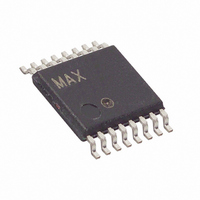MX7705EUE+ Maxim Integrated Products, MX7705EUE+ Datasheet - Page 31

MX7705EUE+
Manufacturer Part Number
MX7705EUE+
Description
IC ADC 16BIT 2CH 16-TSSOP
Manufacturer
Maxim Integrated Products
Datasheet
1.MX7705EPE.pdf
(33 pages)
Specifications of MX7705EUE+
Number Of Bits
16
Sampling Rate (per Second)
500
Data Interface
MICROWIRE™, QSPI™, Serial, SPI™
Number Of Converters
1
Power Dissipation (max)
755mW
Voltage Supply Source
Single Supply
Operating Temperature
-40°C ~ 85°C
Mounting Type
Surface Mount
Package / Case
16-TSSOP
Lead Free Status / RoHS Status
Lead free / RoHS Compliant
Integral nonlinearity (INL) is the deviation of the values
on an actual transfer function from a straight line. This
straight line is either a best-straight-line fit or a line
drawn between the endpoints of the transfer function,
once offset and gain errors have been nullified. INL for
the MX7705 is measured using the endpoint method.
This is the more conservative method.
For an ideal converter, the first transition occurs at 0.5
LSB above zero. Offset error is the amount of deviation
between the measured first transition point and the
ideal point.
In bipolar mode, the ideal midscale transition occurs at
AIN+ - AIN- = 0. Bipolar zero error is the measured
deviation from this ideal value.
With a full-scale analog input voltage applied to the
ADC (resulting in all ones in the digital code), gain error
is defined as the amount of deviation between the ideal
transfer function and the measured transfer function
(with the offset error or bipolar zero error removed).
Gain error is usually expressed in LSB or a percent of
full-scale range (%FSR).
For the ideal transfer curve, the code edge transition
that causes a full-scale transition to occur is 1.5 LSB
below full scale. The positive full-scale error is the dif-
ference between this code transition of the ideal trans-
fer function and the actual measured value at this code
transition. Unlike gain error, unipolar offset error and
bipolar zero error are included in the positive full-scale
error measurement.
For the ideal transfer curve, the code edge transition that
causes a negative full-scale transition to occur is 0.5 LSB
above negative full scale. The negative full-scale error is
the difference between this code transition of the ideal
transfer function and the actual measured value at this
code transition.
Input common-mode rejection (CMR) is the ability of a
device to reject a signal that is common to or applied to
Bipolar Negative Full-Scale Error
Input Common-Mode Rejection
______________________________________________________________________________________
Positive Full-Scale Error
Unipolar Offset Error
Integral Nonlinearity
Bipolar Zero Error
Definitions
Gain Error
16-Bit, Low-Power, 2-Channel,
both input terminals. The common-mode signal can be
either an AC or a DC signal or a combination of the two.
CMR is often expressed in decibels. Common-mode
rejection ratio (CMRR) is the ratio of the differential sig-
nal gain to the common-mode signal gain.
Power-supply rejection ratio (PSRR) is the ratio of the
input signal change (V) to the change in the converter
output (V). It is typically measured in decibels.
Figure 14. Optically Isolated Interface
V
CC
MOSI
MISO
SCK
CS
Sigma-Delta ADC
100Ω
100Ω
Power-Supply Rejection Ratio
V
V
V
CC
CC
CC
2kΩ
6N136
6N136
6N136
100Ω
2kΩ
2kΩ
DIN
SCLK
DOUT
CS
MX7705
3V/5V
ISO
V
DD
31





